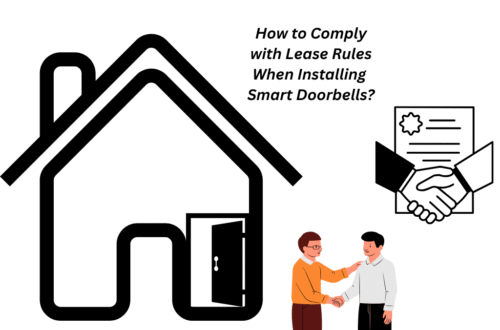
How to Install a Security System Without Landlord Permission?
Landlord control changes to the property. They do not want any damage, structural issues, or insurance complications. Also, they want renters to uphold agreed-upon clauses. They also deserve to know what is added or taken down in their property, even if it is security gear.
Most lease agreements include clauses that prevent tenants from modifying. This includes anything from drilling holes to wiring or mounting devices. Without the written approval of the landlord, no one can amend the property
This also typically counts for installing a camera or a hardwired alarm system. If you skip getting consent and you may be violating your lease or even risking eviction.
Laws and Tenant Rights (Varies by Region)
Renters also preserve their security rights, and they vary from region to region. For example, in Australia, wireless cameras that are not permanently installed are fine, but hardwired systems require written approval and must follow privacy rules. In Canada, landlords cannot forbid cameras inside your private unit. However, they also cannot unilaterally change your lease terms without consent.
Indoor Installations
Renters are usually allowed to install security cameras or detectors inside their rental unit. Especially if these gadgets are battery-powered or non-invasive. These security gadgets should not damage property, invade roommates’ or public privacy. This means that renters should not install cameras in bathrooms or across shared walls. In any case, if the local laws permit indoor cameras, your lease agreement may require you to obtain the landlord’s approval for the installation. So even for the minor fixtures, you will need approval.
Outdoor or Exterior Setups
This includes installing cameras near your front door, balcony, or patio. If you are installing a security gadget anywhere on the building’s exterior, it modifies the property and could affect neighbours or common areas. That’s why you will require written landlord consent. Especially if this gadget has any permanent mounting on the exterior surfaces, uses screws or wiring, or typically, all alterations are covered by most leases.
Always Check Lease Language
Many leases include broad clauses restricting alteration to the property. This often includes security installations. That’s why you, review your lease carefully and determine if you need permission. If the lease says that you need permission before installations, then check which format is required, for example, a written email or a licensed installer.
What Happens If Installed Without Permission?
An unauthorized installation counts as a lease violation, and your landlord may:
- Ask for removal or reparations to restore the premises
- Deduct costs from your security deposit.
- Consider eviction in extreme or repeated cases
- Disputes might be easily resolved, especially if the tenant is cooperative and willing to remove or adjust the setup.

What are the Smart Installation Strategies for Renters?
Tenants should first read their leases and check for changes, installations or safety equipment for the clause. Talk to your landlord in writing, for example, by email or text message. Explain what you want to install, why, how it will affect the property, and you are ready to remove it and repair it before going out. To reduce property damage, give priority to battery-powered or adhesive-mounted options and is more likely to be approved.
- Respect privacy laws and do not record shared hallways, neighbors’ windows or private places
- Respect privacy laws and don’t record shared hallways, neighbors’ windows, or private spaces. Any type of audio recording may also be restricted.
- Use non-damaging and removable options such as
- Adhesive mounts
- Magnetic brackets
- Shelf-placed cameras
- Command-strip security sensors and detectors
- Submit a written request if installing exterior or more permanent devices:
- Clearly outline the type of camera/alarm.
- State location and mounting method.
- Offer to restore/repair walls.
- Explain the benefits of safety and property security, especially if the landlord shares these concerns.
| Scenario | Landlord Permission Required? |
| Indoor, battery-powered camera inside the unit (no drilling) | Typically no, unless the lease forbids |
| Outdoor or front-door camera involving drilling or wiring | Yes, almost always required |
| Mounting in shared/common areas | Yes, usually not allowed anyway |
| Any structural modifications (e.g., wiring, drilling) | Yes, almost always needed |
How to Install a Security System Without Landlord Permission?
Here’s a practical-only guide on installing a security system without landlord permission. We are focusing on solutions that don’t require drilling, rewiring, or altering the property.
1. Use Peel-and-Stick Security Sensors
The security gadgets with peel-and-stick sensors are easily removable and don’t leave any marks. You can attach these sensors to doors, windows, and entry points. When purchasing these sensors, choose brands with long battery life to avoid frequent maintenance. The peel-and-stick sensors include
YoLink Smart Home Starter Kit
It is a top pick for overall performance. Each kit contains an adhesive sensor and a hub which provides an extraordinary range of up to miles. These kit gadgets are fully compatible with Alexa, Google Assistant, and IFTTT for spontaneous smart-home integration. While the sensors themselves are only for indoor use, you can add an outdoor sensor separately
Aqara Door & Window Sensor (with Hub)
These are ultra-small sensors and are easy to hide. These sensors last up to two years on battery. These are a great option for HomeKit users. They are compatible with Alexa, Google, IFTTT, and more.
Why These Make Sense for Renters
Aqara and YoLink offer affordable and practical systems. You can start small and add more sensors as required. Both these options use strong peel-and-stick adhesives, so they can be installed and removed without damaging walls and doors. This makes them perfect for rented conditions where you cannot drill or modify the surfaces. Also, they offer reliable battery life. For example
- Aqara lasts up to two years on a battery.
- YoLink sensors are also designed to be low-maintenance (long-lasting battery performance is typical for these).
2. Install Battery-Powered Cameras
These cameras are mounted with adhesive pads, magnetic bases, or small clamps instead off screws. You can install them without landlord permission, as no wiring is required and they are fully portable if you move. However, select models with cloud storage so you don’t need a DVR system. The battery-powered cameras include:
Tapo C420S2 Smart Wire‑Free Security Camera System
This is a 2-camera kit that offers 2K QHD resolution and up to 180 days of battery life. These cameras also have color night vision with intelligent AI detection. They are fully wireless, which makes them ideal for sticky-mount setups in rental spaces.
Ezviz CB1 Battery Camera
It is a compact and budget-friendly battery-powered camera. Ezviz CB1 is best for discreet placement around your home. While basic, it’s practical and effective for renters needing simple indoor monitoring.
Why These Make Sense for Renters
These cameras offer adhesive or magnetic mounts and are easy to relocate. There is no need for wiring or drilling. The battery lasts for up to 180 days. They also provide smart alerts and cloud storage along with AI detection to ensure you only get important notifications.
3. Use Freestanding Indoor Security Cameras
These freestanding indoor security cameras offer instant setup and easy relocation. You just need to put them on shelves, countertops, or furniture near power outlets. However, you should angle the camera to cover multiple entry points with one device. These gadgets include:
Tapo C120 Indoor/Outdoor Wi‑Fi Security Camera
It is a robust 2K camera with color night vision. It also offers IP66 weather resistance and 24/7 coverage. This camera works great on-shelf indoors but is also good for occasional outdoor use. You get clear footage day or night without drilling or wiring.
EZVIZ CB3 Standalone Battery Camera
This is a totally wire-free camera, which is perfect for renters. It runs on a battery and you can place it anywhere near an outlet. It’s portable and handy for shifting areas as needed.
Why These Make Sense for Renter
Just plug into a power outlet or use battery power (depending on model). You just need to place it on a shelf or table, and you’re done, no tools or installation hassle. When you move or want to shift coverage, just pick it up and place it somewhere new. However, you need to position is wisely.
4. Try Plug-and-Play Smart Doorbell Cameras
These security cameras use a no-drill mount or attach over your existing peephole. So there is no need to make permanent changes to the door or wiring. However, you should look for models with two-way audio for visitor screening. These products include:
Tapo D235 Video Doorbell Camera
This camera features 2K QHD video, two-way audio, wide-angle, and motion detection. It is designed for simple installation. Adhesive mounting over existing peepholes makes it renter-friendly and portable.
Xiaomi Smart Doorbell 3
Offers sharp 2K resolution and ultra-wide-angle coverage, with a battery that lasts around 4.8 months. It is ideal for quick setup without any tools. You just stick it up and add cloud-based monitoring.
Why These Make Sense for Renter
Both the Tapo D235 and Xiaomi Doorbell 3 can be mounted using adhesive or rubberized pads. You don’t need screws, no holes, and fully removable when you move. These models include built-in microphones and speakers, enabling you to talk to visitors from your phone. This makes them perfect for screening anyone at the door from a distance.
5. Choose Portable Motion Detectors
It works by placing the battery-powered detectors on shelves or walls using removable adhesives. You can use it in hallways, near windows, or in shared spaces without installation. You should go for adjustable sensitivity to avoid false alarms from pets.
Why These Make Sense for Renter
Stick them on walls with adhesive strips or place them on a shelf. No drilling or wiring required. You can also move them around to cover different zones such as hallways, shared entryways, or near windows. Their proper positioning and sensitivity settings help avoid false alarms triggered by pets or airflow. Whether you need to shift them from your living room to your kitchen, it’s as easy as peel and stick.
Conclusion
Tenants do have the right to safety but that often comes with the responsibility to respect lease terms and property rules. Written landlord approval is generally required for any fixture that could be seen as altering the property. By communicating clearly, choosing low-impact systems, and securing proper permission first, you can enhance your security safely and legally.
FAQs
What happens if you’ve already installed something without the landlord’s approval?
If you have already installed something without the landlord’s approval, then it will be considered a lease breach. Your landlord may request removal or demand repairs to return the property to its original condition. It is best to communicate openly and explain your concerns. Try to negotiate with them.
How to approach such a situation wisely?
In such a case, read your lease carefully. See what alterations or installations require landlord permission. After that, submit a clear, written request. Explain what device you plan to install. Tell them whether it’s battery-powered or needs drilling. Also, inform them about your willingness to restore the space before moving out.
What are the better alternatives for renters’ security?
If your landlord isn’t comfortable with installations, then you should consider:
- Wireless video doorbells with adhesive or no-drill mounts.
- Cordless plug‑and‑go cameras are placed strategically indoors.
- Portable personal alarms or door‑stop alarms because they require zero modifications and boost your safety instantly.




